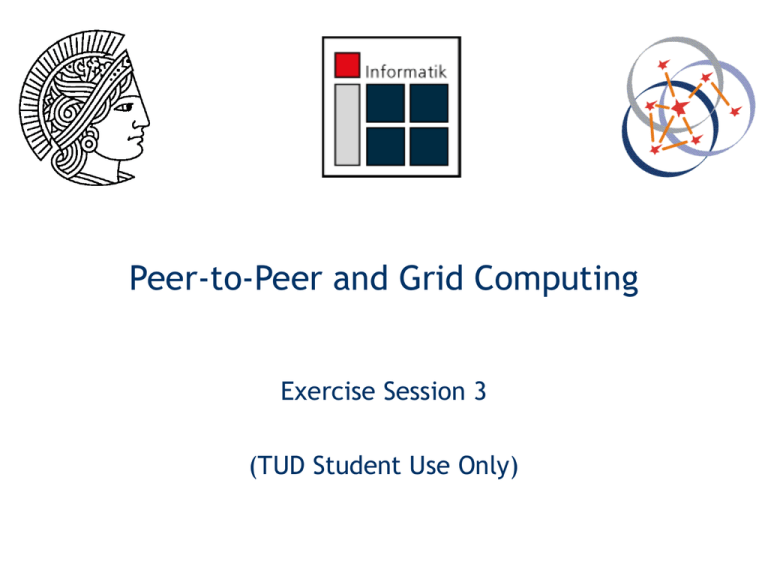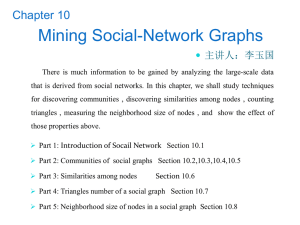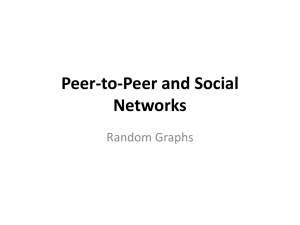Peer-to-Peer and Grid Computing
advertisement

Peer-to-Peer and Grid Computing Exercise Session 3 (TUD Student Use Only) Ubiquitous Peer-to-Peer Infrastructures Group Department of Computer Science Agenda Graph Metrics Small World Random Graph Power Law Dr. Michael Welzl P2P and Grid Computing WS 07/08 Ubiquitous Peer-to-Peer Infrastructures Group Department of Computer Science Gaph Metrics Dr. Michael Welzl P2P and Grid Computing WS 07/08 Ubiquitous Peer-to-Peer Infrastructures Group Department of Computer Science Important Graph Metrics • Distance: d(v, u) between vertices v and u is the length of the shortest path between v and u • Average path length: Sum of the distances over all pairs of nodes divided by the number of pairs • Diameter: d(G) of graph G is the maximum of d(v, u) for all v, u V • Order: the number of vertices in a graph • Clustering coefficient: number of edges between neighbors divided by maximum number of edges between them E(N(i)) C(i) d(i)(d(i) 1) E(N(i)) = number of edges between neighbors of i d(i) = degree of i Dr. Michael Welzl P2P and Grid Computing WS 07/08 Source: Wikipedia Ubiquitous Peer-to-Peer Infrastructures Group Department of Computer Science Small World Dr. Michael Welzl P2P and Grid Computing WS 07/08 Ubiquitous Peer-to-Peer Infrastructures Group Department of Computer Science Small-World Networks and Random Graphs • Results – Compared to a random graph with same number of nodes – Diameters similar, slightly higher for real graph – Clustering coefficient orders of magnitude higher • Definition of small-worlds network – Dense local clustering structure and small diameter comparable to that of a same-sized random graph Dr. Michael Welzl P2P and Grid Computing WS 07/08 Ubiquitous Peer-to-Peer Infrastructures Group Department of Computer Science Constructing Small-World Graphs • Put all n nodes on a ring, number them consecutively from 1 to n • Connect each node with its k clockwise neighbors • Traverse ring in clockwise order • For every edge – Draw random number r – If r < p, then re-wire edge by selecting a random target node from the set of all nodes (no duplicates) – Otherwise keep old edge • Different values of p give different graphs – If p is close to 0, then original structure mostly preserved – If p is close to 1, then new graph is random – Interesting things happen when p is somewhere in-between Dr. Michael Welzl P2P and Grid Computing WS 07/08 Ubiquitous Peer-to-Peer Infrastructures Group Department of Computer Science Regular, Small-World, Random Regular Small-World p=0 Random p=1 Dr. Michael Welzl P2P and Grid Computing WS 07/08 Ubiquitous Peer-to-Peer Infrastructures Group Department of Computer Science Problems with Small-World Graphs Small-world graphs explain why: • Highly clustered graphs can have short average path lengths (“short cuts”) Small-world graphs do NOT explain why: • This property emerges in real networks – Real networks are practically never ring-like Further problem with small-world graphs: • Nearly all nodes have same degree • Not true for random graphs • What about real networks? Dr. Michael Welzl P2P and Grid Computing WS 07/08 Ubiquitous Peer-to-Peer Infrastructures Group Department of Computer Science Random Graph Dr. Michael Welzl P2P and Grid Computing WS 07/08 Ubiquitous Peer-to-Peer Infrastructures Group Department of Computer Science Random Graphs • Random graphs are first widely studied graph family – Many P2P networks choose neighbors more or less randomly • Two different notations generally used: – Erdös and Renyi – Gilbert (we will use this) • Gilbert’s definition: Graph Gn,p (with n nodes) is a graph where the probability of an edge e = (v, w) is p Construction algorithm: • For each possible edge, draw a random number • If the number is smaller than p, then the edge exists • p can be function of n or constant Dr. Michael Welzl P2P and Grid Computing WS 07/08 Ubiquitous Peer-to-Peer Infrastructures Group Department of Computer Science Basic Results for Random Graphs Giant Connected Component Let c > 0 be a constant and p = c/n. If c < 1 every component of Gn,p has order O(log N) with high probability. If c > 1 then there will be one component of size n*(f(c) + O(1)) where f(c) > 0, with high probability. All other components have size O(log N) • In plain English: Giant connected component emerges with high probability when average degree is about 1 Node degree distribution • If we take a random node, how high is the probability P(k) that it has degree k? • Node degree is Poisson distributed – Parameter c = expected number of occurrences c k e c P(k) k! Clustering coefficient • Clustering coefficient of a random graph is asymptotically equal to p with high probability Dr. Michael Welzl P2P and Grid Computing WS 07/08 Ubiquitous Peer-to-Peer Infrastructures Group Department of Computer Science Random Graphs: Summary • Before random graphs, regular graphs were popular – Regular: Every node has same degree • Random graphs have two advantages over regular graphs 1. Many interesting properties analytically solvable 2. Much better for applications, e.g., social networks • Note: Does not mean social networks are random graphs; just that the properties of social networks are well-described by random graphs • Question: How to model networks with local clusters Dr. Michael Welzl P2P and Grid Computing WS 07/08 and small diameter? Ubiquitous Peer-to-Peer Infrastructures Group Department of Computer Science Power Law Dr. Michael Welzl P2P and Grid Computing WS 07/08 Ubiquitous Peer-to-Peer Infrastructures Group Department of Computer Science Power Law Networks • Also known as scale-free networks • “Power Law” relationship for Web pages – The probability P(k) that a page has k links (or k other pages link to this page) is proportional to the number of links k to the power of y • General ”Power Law” Relationships – A certain characteristic k is – independent of the growth of the system – always proportional to ka, whereby a is a constant (often -2 < a < -4) • Power laws very common (“natural”) – and power law networks exhibit small-world-effect – E.g. WWW: 19 degrees of separation (R. Albert et al, Nature (99); S. Lawrence et al, Nature (99)) Dr. Michael Welzl P2P and Grid Computing WS 07/08 Ubiquitous Peer-to-Peer Infrastructures Group Department of Computer Science Examples for Power Law Networks • Economics – Pareto: income distribution (common simplification: 20% of population own 80% of the wealth) – Standardized price returns on individual stocks or stock indices – Sizes of companies and cities (Zipf’s law) • Human networks – professional (e.g. collaborations between actors, scientists) – social (friendship, acquaintances) – Sexual-contact networks • Many other natural occurrences – Distribution of English words (Zipf’s law again) – Areas burnt in forest fires – Meteor impacts on the moon • Internet also follows some power laws – Popularity of Web pages (possibly related to Zipf’s law for English words?) – Connectivity of routers and Autonomous Systems – Gnutella’s topology! Dr. Michael Welzl P2P and Grid Computing WS 07/08 Ubiquitous Peer-to-Peer Infrastructures Group Department of Computer Science Barabasi-Albert-Model • How do power law networks emerge? – • In a network where new vertices (nodes) are added and new nodes tend to connect to well-connected nodes, the vertex connectivities follow a powerlaw Barabasi-Albert-Model: power-law network is constructed with two rules 1. Network grows in time 2. New node has preferences to whom it wants to connect • Preferential connectivity modeled as – – Each new node wants to connect to m other nodes Probability that an existing node j gets one of the m connections is proportional to its degree d(j) • New nodes tend to connect to well-connected nodes • Another way of saying this: “the rich get richer” Dr. Michael Welzl P2P and Grid Computing WS 07/08 Ubiquitous Peer-to-Peer Infrastructures Group Department of Computer Science Robustness of Scale Free Networks • Experiment: take network of 10000 nodes (random and power-law) and remove nodes randomly • Random graph: – Take out 5% of nodes: Biggest component 9000 nodes – Take out 18% of nodes: No biggest component, all components between 1 and 100 nodes – Take out 45% of nodes: Only groups of 1 or 2 survive • Power-law graph: – Take out 5% of nodes: Only isolated nodes break off – Take out 18% of nodes: Biggest component 8000 nodes – Take out 45% of nodes: Large cluster persists, fragments small • Networks with power law exponent < 3 are very robust against random node failures – ONLY true for random failures! Dr. Michael Welzl P2P and Grid Computing WS 07/08 Ubiquitous Peer-to-Peer Infrastructures Group Department of Computer Science Robustness of Scale-Free Networks /2 • Robustness against random failures = important property of networks with scale-free degree distribution – • But scale-free networks are very sensitive against attacks – • Remove a randomly chosen vertex v from a scale-free network: with high probability, it will be a low-degree vertex and thus the damage to the network will not be high If a malicious attacker removes the highest degree vertices first, the network will quickly decompose in very small components Note: random graphs are not robust against random failures, but not sensitive against attacks either (because all vertices more or less have the same degree) Failure of nodes Dr. Michael Welzl P2P and Grid Computing WS 07/08 Ubiquitous Peer-to-Peer Infrastructures Group Department of Computer Science Robustness of Scale-Free Networks /3 • Random failures vs. directed attacks Dr. Michael Welzl P2P and Grid Computing„Power WS 07/08 Law“ Graph Random Graph Ubiquitous Peer-to-Peer Infrastructures Group Department of Computer Science Questions? Main Goal of session: Difference between Random Graph / PowerLaw / Small World Creation of these graphs Dr. Michael Welzl P2P and Grid Computing WS 07/08 21








